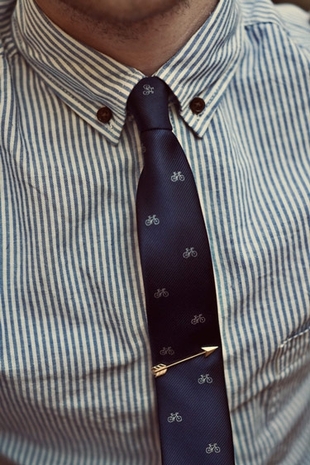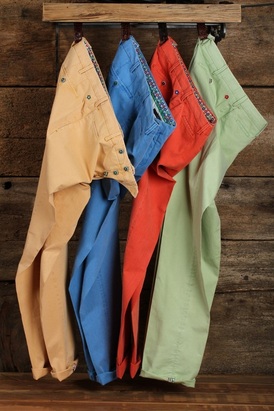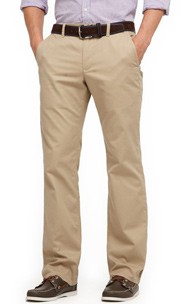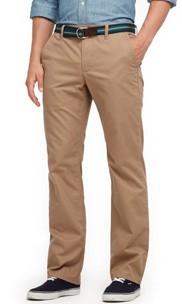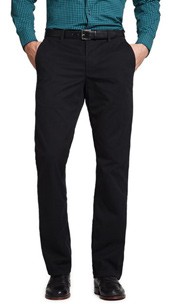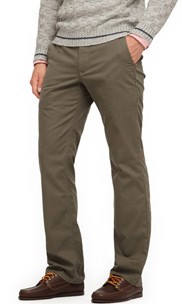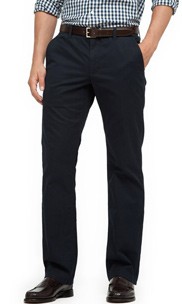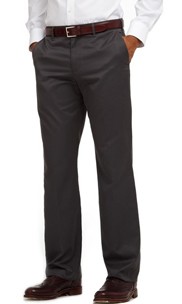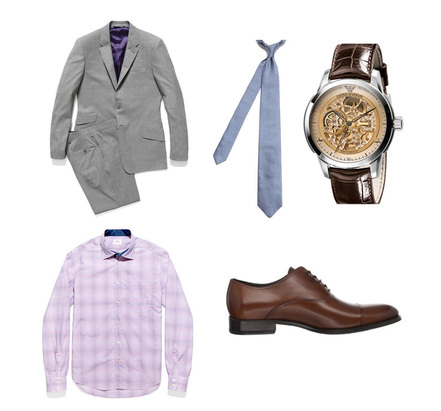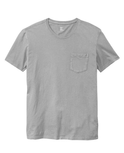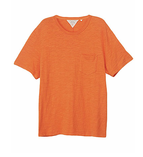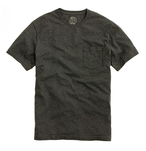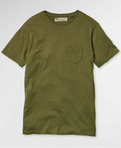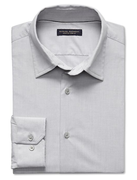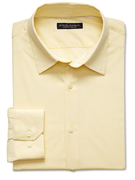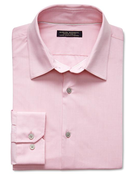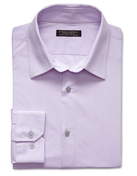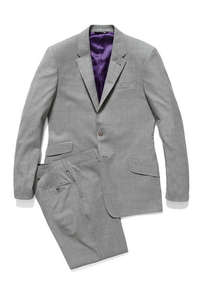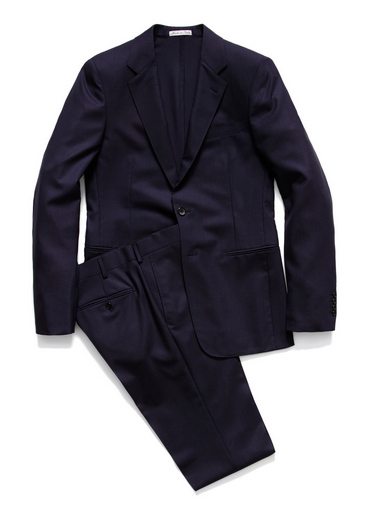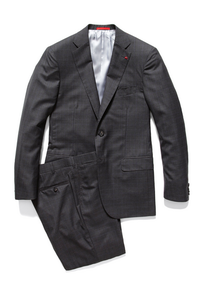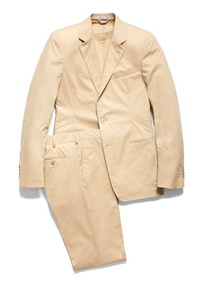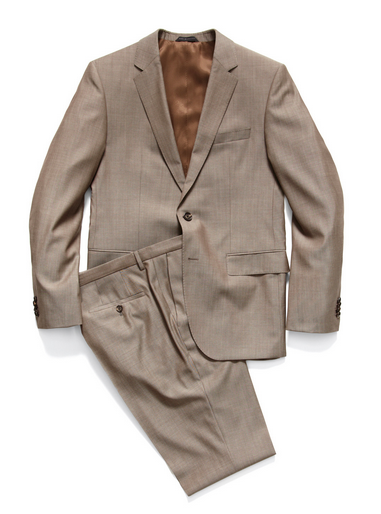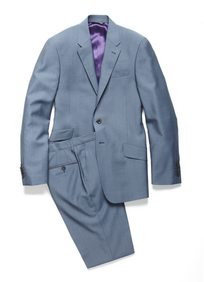|
As far as male accessories go, there aren't many options. As I've said before, a watch is a must, but beyond that, jewelry can be inappropriate or hard to pull off and cuff links require a specific type of shirt. And as the trend in menswear has become dressing up on a regular basis, the tie bar is the perfect way to accent an outfit. If you're going to go for this revitalized trend, go with silver or gold (whichever you wear more) in a very plain design. If you're going to go all out and buy a few, you can get creative like the one in the picture, especially to wear for more informal tie-wearing occasions. Make sure the bar doesn't extend past the width of the tie, and don't use a super short one on a regular width tie, it looks disproportional. This is a really easy way to upgrade and outfit or add interest to a plain tie or suit if you get bored with it. The Tie Bar is a good place to start for both ties and tie bars. If it's not your style, it's not a big deal, but if you're looking for an easy upgrade or finishing touch, this is a great way to add a fashion forward accent to an outfit.-E
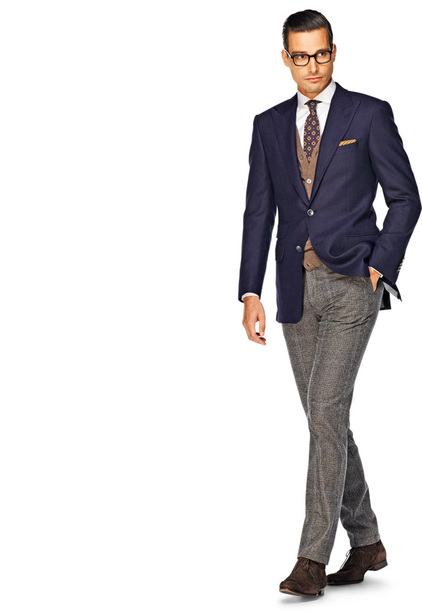 Pocket square not required, but done right it can't hurt. Thanks to Suit Supply for perfect styling. So now you have all the pants you need, and you know what to look for in a shirt, but for those formal occasions that don't quite require a suit, you're lost. Slapping a tie on doesn't really solve the problem, especially because a tie with no jacket is sort of pointless. You need a middle ground. Enter the blazer. A sport coat also works here, and they are different things, but for style purposes they can be worn the same. Neutral is key here. Navy is the most common, but a black or understated gray can be equally as versatile. The blazer is great because it adds a formal look to an outfit without making you look overdressed, and you can pair it with many different shirt/pants/tie (if necessary) combinations. Dress up jeans with a blazer, or throw one over a shirt and dress pants for an after-work formal look. Wear it with your sockless shoe in the summer and layer it with a sweater and button down in the fall and winter (see this impeccably done above). The possibilities are literally endless. I'm partial to the traditional navy blazer, but just make sure you get a color that works best with your wardrobe and a fit that makes you carry off this look convincingly. Once you add this item to your closet, you probably will wonder what you did before you had it. -E
Every man should own a suit, and most men probably own at least one pair of jeans, and rightfully so. But on a daily basis, if you don't have to wear a suit to work every day, you have to find other ways to mix it up. Things can get boring, so color variety down under can bring your shirts and ties (if necessary) back to life.
The first thing you should do when you're shopping for pants, is find a pair that fits. As always, they don't have to be expensive, as long as they fit well. Which means you might have to visit a tailor. They shouldn't be too low rise, and if you can't find a length that's good for you, err long and get them hemmed. Especially for work, these shouldn't be too skinny, you shouldn't feel like they're about to rip off of you; baggy pants are also a crime, your legs shouldn't have too much room to move around inside the pant leg. And no pleats. Ever. Straight leg is going to be your best bet, because even those should taper about an inch from your thigh to your ankle. Even if you're a set size, every store's pants will fit a little differently, so find your magic pair...then buy all 6 necessary colors in that style (plus more, if you wish!).
And so for the six. In your closet, you should have the following: black (non-suit) pants, gray pants (light or dark, but both is preferable. You can do dress pants or khakis, depending on which your life demands more), darker khakis, lighter (but not too light) khakis, green (hunter, not kelly) and navy. Owning these will insure a wide variety of shirt/pants combinations, and no matter which pants you choose to wear, you will always look better than casual. These will span a range of different dress codes and you won't always look like your mom laid your clothes out for you to go to a school dance. This mix will give you neutral staples as well as updates to those so you can vary what you wear and easily give your work or nighttime attire a more stylish edge.
Some examples: For some good options in all price ranges, try: Express, J.Crew, Gap, Bonobos (got their start selling better-fitting pants), Mr. Porter (for the über trendy), Suit Supply. All pants pictured above are various colors of the Bonobos straight leg style. -E
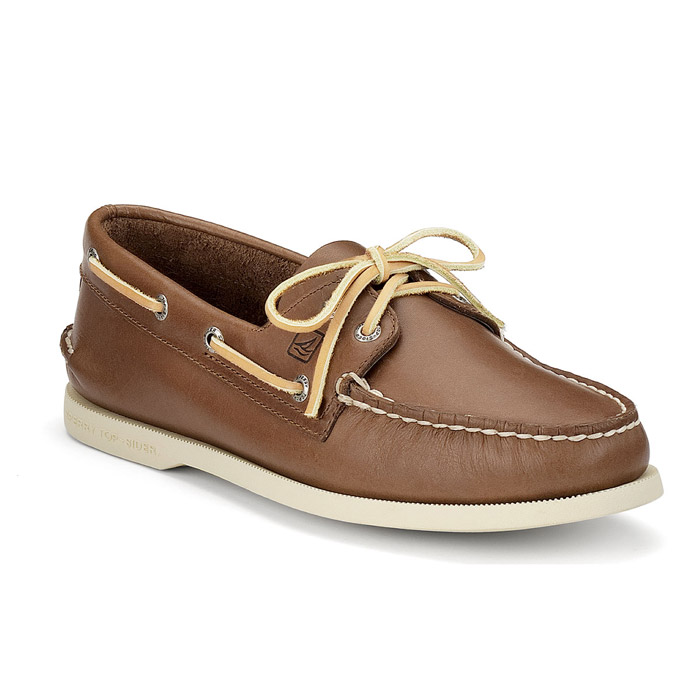 This brown will go with anything you'd want to wear short of a dressy occasion, more versatile than even the original Sperry color. |  The laceless design and rich leather make this a slightly dressier alternative to the boat shoe, but the two are nearly interchangeable in an everyday outfit. | As men, you don't really have many opportunities to free your feet. Mandals are not universally accepted, and most other footwear requires socks. In the summer, that can get hot, and with shorts....let's not even go there. That's why it's essential to own at least one pair of sockless shoes. Now, I'm not talking about any shoes that you buy with the intention of reserving them only for sockless occasions. There are shoes that are and are not acceptable to wear without socks, and you need to at least own one pair. These are most likely going to be for casual or dressy-casual (worst dress code ever) occasions, and most basically I'm talking a boat shoe or a loafer.
Get these in a good not-too-dark brown so they can go with everything and will look good dressed up or down, with pants or shorts, the works. If you're only going to have one pair, it doesn't really matter whether you go with the loafer or the boat shoe, but the loafer is going to be able to be dressed up more. Go with traditional shapes and colors and you can't go wrong. Most men don't realize the difference opting for the sockless semi-dress shoe over the sneaker can make in an outfit. It's an across the board instant upgrade, and not only will your feet thank you for some freedom during the summer months, those around you will thank you for leaving the mandals at home.
Note: In colder months, socks with loafers (NOT boat shoes) can be acceptable. But it can also be tacky and disastrous. Study up and make sure you do it right before you jump in.
-E
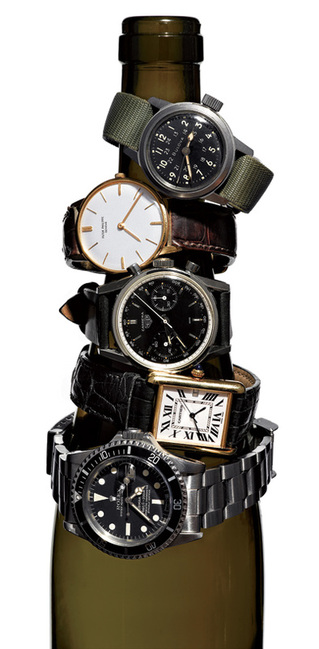 Photo via GQ.com. While women have their earrings, bracelets necklaces and rings, men really only have their watches. Yes, there are an assortment of other accessories men can choose from, but I don't see many men sporting a tie bar on a regular basis, and I bet most can count the number of times they break out their cuff links in a year. The watch is the only every day accessory a man gets to have, and every man should have one. Your watch is a pretty important decision. You'll have to see it most days, and it has to work with everything from a suit to shorts and a t-shirt. While in a perfect world, every man would have several watches for different occasions, that can get pretty pricey. I believe that watches, like all menswear, are not about how much they cost, but about how they look and how you like them. In my semi-limited experience with watch consulting, I haven't found an expensive, aspirational watch that doesn't have a satisfactory affordable counterpart.* So for your one watch, pick well and don't settle. It's one of the few places you really get to distinguish yourself in an outfit. If it takes a little more time to find the one you want, it's okay, it's worth it for the amount of time you'll wear it. And don't be daunted by the choice, with just a few easy steps (below, the whole point of this post), your wrist will no longer be naked, and you'll have no excuse to pull out your phone when someone asks you for the time.
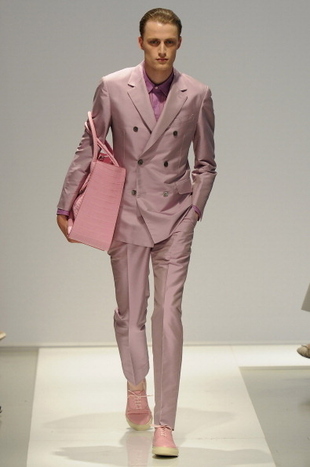 This is bold. And he's carrying a murse. Probably don't do this for a first impression. odds + ends There are a lot of other things to consider when polishing off your outfit, once you've got the basics down. Pending your destination, not all apply, but for the final post in the series, here are some last little details to consider before stepping out the door. socksSocks have become a thing these days, but for an interview, keep them toned down. If you want to go fun, keep your socks in a dress color and go with a pattern. If your place of interview is a little more relaxed or creative, you might be able to get away with a fun red, yellow or other bright under the pant. Wear this trend with caution. What would be fun for a daytime summer wedding might not impress your future boss. watchJust yes. You should always wear one. Always. The intricacies of the right or wrong watch are far too long for this post, if there is even a right or wrong. Watches are a personal preference and there are a lot of really nice and a lot of really questionable options out there. Just know that your suit will seem pretty incomplete without the watch, whether it's the only accessory you're wearing or not. It doesn't have to be a Rolex, but it should be on your wrist. beltI'm of the belief that a belt isn't an absolute necessity, but a lot of people would disagree with me. I also don't necessarily believe that your belt has to match your shoes (especially if you go with an oxblood or lighter brown), but people might yell at me then, too. For these purposes, I'm going to say, if you feel like you need to wear a belt, make it match and keep it simple. The buckle should be minimalistic and should not attract attention to your waist, and neither should the hue of the belt, especially if it's because it doesn't appropriately complement your shoe color. tie barIf you have a nice one, go for it! Nothing too showy or cheesy, but this little detail might tell your interviewer that you pay attention to the little things and care about polishing yourself up. If it's not your style, don't sweat it, it's definitely a take-it-or-leave-it accessory. cuff linksIn the off chance you're wearing a french cuff shirt, keep the cuff links simple and understated. You don't want to send the wrong message at the first handshake, and too much glitz by your wrist might do that if the light strikes your cuff links just right. Opt for your plainest pair and don't think too hard about it, they're a means to an end in this case. the bagIf you want to bring one, keep it sleek and nice-looking. An interview is no place for your dirty, nylon messenger bag. Opt for a leather choice that complements the other leather aspects of your suit and isn't so ambiguous in style that it will cause questions. A briefcase or simple messenger are going to be your safest bets. If you're bag-averse, go with a traditional padfolio. This is another matter of personal preference. There's a standard, but not a rule, so meet the standard and you're good to go. a few last words
a don't
Jewelry. Take it off for an interview, or make sure it is completely and permanently out of sight. Jewelry will most definitely be part of a first impression, and apart from a wedding band, there is no reason it should be, because it will nearly always make you stick out in the wrong way.
And after all this preaching, you might be wondering what I ended up telling my brother to wear. His options were limited, so we went with a navy, 3-button suit (middle button only buttoned), a light blue button down and yellow tie with dark and light blue check pattern. He only had black dress shoes (I would have gone with something different if I had the choice), and of course a watch. His has a metal band, yours doesn't have to.
He got hired on the spot, so I'm not going to not say that my advice leads you in the right direction. When you're suiting up, use your head, look in the mirror and wear your interview look with confidence.
-E
Okay, so you're suited up, shirt tucked in and you need those final details before you put on your shoes and go. Today is about those two big details you can't leave home without.
the tie It's such a simple addition, and some argue that it's wholly unnecessary these days. But that aside, you need a tie. And although you can have a little fun with your interview outfit/suit in general, you can only have limited fun with your suit accessories in a professional setting. No bow ties or skinny ties here (as much as it pains me to say), and go easy on the pattern mixing.; there's a fine line between just right and too much. Go with a knot that's comfortable, but fits correctly with the corresponding collar.
The easy and traditional thing to do is to go with a white or light blue shirt with a straight or semi-spread collar and patterned tie, and although that's not wrong, per se, you'll stand out if you go with a well-patterned shirt and solid tie, in the correct color combination. It's a striking look that's on the rise as patterned shirts are having a moment. If you're too afraid of the pattern mix or you've already got a suit-on-shirt pattern mix and don't want to tempt anything with a third pattern, it's a go-to that won't let you down. the shoes The shoes can be tricky, and they can really break a suit outfit if they're bad enough. If you're going to own only one pair of dress shoes, they should be black, and the toe shape should be neutral--not too round, not too pointy, not too square. The style is really up to you. A plainer dress shoe is probably the most versatile, but an oxford is a nice wardrobe component. If you don't like laces, there are nice no-lace options, but it's personal preference once you've chosen a good shape.
Of course, you should have an alternative to black in your closet arsenal as well. A mid-brown is going to be the most go-with-everything for your money, but if shoes are your thing, a good oxblood can also serve that purpose. A darker brown is harder to pair with the colors suits tend to come be, but the right shade in the right finish can go a long way if it's not your only pair of dress shoes. The shape principle still applies to these other colors, and I recommend having a trusty black and a brown/oxblood to go with your black, and all your grays and navys. Then if you still don't feel footwear fulfilled, you can go for more adventurous styles, designs and even colors.
-E
The first thing that comes to mind when I think of a men's pocket tee is this ratty turquoise one my dad had, and wore almost exclusively to do yard work. This is a very sub-par representation of the potential this simple garment holds in a man's wardrobe. It is at very least a staple, and every man should own a handful of these in whatever colors and levels of wear he wants. Mens' outfits consist of so few items that they should all look good, and the pocket tee makes it easy for that to happen. On a casual day, throw this on with jeans or shorts and a pair of boat shoes or desert boots and you'll look like you tried with very minimal actual effort. If necessary, a white one can serve as an undershirt, or it can be worn under sweaters or blazers on cooler days. The possibilities are endless. Most men think straight to button downs and polos when they think of a quick and easy outfit, but the very basic, very casual, but classic pocket tee should not be forgotten. Switch out some of your stained and faded college t-shirts and graphic tees that will do nothing to boost your sophistication in favor of a few well-fitting pocket tees. They don't have to be expensive, they just have to look good. When paired with other nice looking items (no horrible jeans, no gross gym shoes and please not over a long sleeved t-shirt), a pocket tee can make an outfit just as well as a shirt and tie. -E t-shirts: Gap, Rag & Bone, J.Crew, Levi's
the shirt The suit might cover the most surface area on a guy, but the shirt is what really sets the tone of the outfit. In the past, ties used to get all the attention. Shirts now come in varieties that invite you to be creative with the rest of your outfit, especially considering it's what you see if the suit jacket comes off. You just have to know how to combine colors and patterns in a way that works, and that's what I'm here for.
Before I go into what could ultimately be an endless exploration of the world of button downs (don't worry, I'll control myself), there's one piece of advice I want to give. I have to admit the fact that though I'm about to endorse everything but the traditional dress shirt, before you can take those leaps, you need the foundation of a white and light blue traditional dress shirt. In reality, you should get two of each, but should you need to be more conservative, this is the only way to go. And as usual, make sure it fits. Shirts come in a lot of different fits, and too tight or too billowy is not the right fit for anyone.
Moving on. Let's start with color. Solid colors will get you very far, especially if your favorite tie is one that doesn't sit well with other patterns. Apart from the blue and white shirts every man should have, stick with solids in agreeable colors, usually ones on the lighter side. You don't want to appear to be cheering on your favorite school.
These colors go well with any basic colored suit you should own, and even some non-traditional ones, like khaki. Patterns are where you get to have the most fun, but in a professional setting, you don't get to have too much fun. Stick to sophisticated patterns, again, in colors that can go with any suit and many tie options. The subtler, the better, but that doesn't mean you have to snooze over your choices.
Patterns can also add a lot of interest to your wardrobe and give you more options. Wearing patterns with a suit can often set you apart from other suit-wearers, especially if you expertly pattern mix with a tie or wear a well-matched solid tie. Like with solids, subtle is better, but because the color is less saturated on the shirt, you can incorporate bolder colors here with more condensed patterns. Patterns also add versatility and personality to your wardrobe when, after the interview, you don't always have to don the full suit or wear a tie.
the suit My brother found out about a job interview with just two days notice, and texted me in a mild panic requesting suit advice for the big day. Beyond knowing that he should wear a suit, he was a little lost. It occurred to me that because much of the male population isn't exactly sartorially inclined (no offense), this might be a problem a lot of guys face. So here's the advice I gave my brother.
My first rule is that a man should always wear a suit to a job interview. I don’t care if you’re trying to be a janitor or a CEO; wear a suit unless you're told otherwise. Second, make sure your suit fits. You might as well wear your PJ's if it doesn’t.
These non-black neutrals leave a lot of room for a variety of shirt/tie combinations and can be worn all year round.
But just getting a suit on your body doesn’t mean you’re done. Men don’t have much flexibility when it comes to interview attire, so attention to details can be the best way to set yourself apart from other candidates. Try to stay away from plain black. The fact that you’re wearing a suit is formal enough, and unless you’re applying for a job on Wall Street, you don’t have to be quite that conservative. Grays, navys and subtle patterns will look just as professional, but will also give you an opportunity to differentiate yourself.
If you're really confident in your ability to pull off a suit, these less conventional neutrals can be an interesting alternative if done right.
|
|
